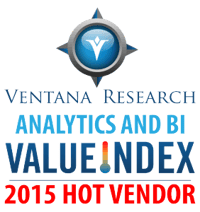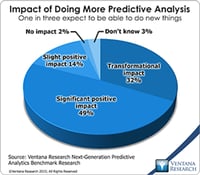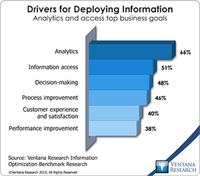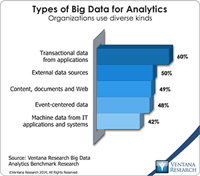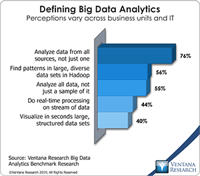Enterprise messaging is the technology backbone of communications for applications and systems within and between organizations. Both its importance and its complexity are growing as organizations increasingly have to provide real-time responses to business customers and consumers as well as their own business professionals who support them and their internal supply chains. The variety of use cases for enterprise messaging also is growing rapidly, expanding to the Internet of Things (IoT)...
Read More
Topics:
Big Data,
Social Media,
Enterprise messaging, Internet of Things, IoT, mid,
Operational Performance Management (OPM),
Cloud Computing,
Governance, Risk & Compliance (GRC),
Operational Intelligence,
Uncategorized,
Business Performance Management (BPM),
Customer Performance Management (CPM),
Information Management (IM),
Information Optimization,
Supply Chain Performance Management (SCPM)
I hope this title captures your attention; I’m trying to make a point about the chaos going on in managing and operating marketing. What marketing needs in 2016 is to manage and optimize its efforts in a more unified manner. This perspective kicks off a new series on the challenges for marketing to automate or execute tasks and manage toward maximum performance. We all know that the craft of marketing is in need of significant transformation, from the CMO throughout the entire marketing...
Read More
Topics:
Big Data,
Predictive Analytics,
Social Media,
Operational Performance Management (OPM),
Business Analytics,
Business Collaboration,
Business Intelligence,
Cloud Computing,
Location Intelligence,
Operational Intelligence,
Uncategorized,
Business Performance Management (BPM),
CMO,
Customer Performance Management (CPM),
Financial Performance Management (FPM),
Information Applications (IA),
Information Optimization,
Sales Performance Management (SPM)
At the 2015 technology analyst summit in Austin, Texas, analytics and business intelligence software vendor Qlik discussed recent market and product developments and explained its roadmap and strategy for 2016. Discussion topics included its Qlik Analytics Platform and QlikView 12.0, Qlik Sense and Qlik DataMarket, applications built on the platform but also how it is expanding its analytics experience for business.
Read More
Topics:
Big Data,
Business Analytics,
Business Intelligence,
Governance, Risk & Compliance (GRC),
Operational Intelligence,
Uncategorized,
Business Performance Management (BPM),
Information Management (IM),
Information Optimization
Technology innovation is accelerating faster than companies can keep up with. Many feel pressure to adopt new strategies that technology makes possible and find the resources required for necessary investments. In 2015 our research and analysis revealed many organizations upgrading key business applications to operate in the cloud and some enabling access to information for employees through mobile devices. Despite these steps, we find significant levels of digital disruption impacting every...
Read More
Topics:
Big Data,
Predictive Analytics,
Social Media,
Human Capital,
Operational Performance Management (OPM),
Analytics,
Business Analytics,
Business Collaboration,
Business Intelligence,
Cloud Computing,
Governance, Risk & Compliance (GRC),
Location Intelligence,
Operational Intelligence,
Uncategorized,
Business Performance Management (BPM),
Customer Performance Management (CPM),
Financial Performance Management (FPM),
Information Applications (IA),
Information Management (IM),
Sales Performance Management (SPM),
Supply Chain Performance Management (SCPM)
Data is an essential ingredient for every aspect of business, and those that use it well are likely to gain advantages over competitors that do not. Our benchmark research on information optimization reveals a variety of drivers for deploying information, most commonly analytics, information access, decision-making, process improvements and customer experience and satisfaction. To accomplish any of these purposes requires that data be prepared through a sequence of steps: accessing, searching,...
Read More
Topics:
Big Data,
Predictive Analytics,
Operational Performance Management (OPM),
Analytics,
Business Analytics,
Business Collaboration,
Business Intelligence,
Business Mobility,
Cloud Computing,
Data Preparation,
Location Intelligence,
Operational Intelligence,
Business Performance Management (BPM),
Customer Performance Management (CPM),
Financial Performance Management (FPM),
Information Applications (IA),
Information Management (IM),
Information Optimization,
IT Performance Management (ITPM),
Sales Performance Management (SPM),
Supply Chain Performance Management (SCPM),
Workforce Performance Management (WPM)
Big data has become a big deal as the technology industry has invested tens of billions of dollars to create the next generation of databases and data processing. After the accompanying flood of new categories and marketing terminology from vendors, most in the IT community are now beginning to understand the potential of big data. Ventana Research thoroughly covered the evolving state of the big data and information optimization sector in 2014 and will continue this research in 2015 and...
Read More
Topics:
Big Data,
MapR,
Predictive Analytics,
SAP,
Human Capital,
Mulesoft,
Operational Performance Management (OPM),
Paxata,
SnapLogic,
Splunk,
Business Analytics,
Business Intelligence,
Cloud Computing,
Cloudera,
Hortonworks,
IBM,
Informatica,
Information Management,
Operational Intelligence,
Oracle,
Business Performance Management (BPM),
Customer Performance Management (CPM),
Datawatch,
Dell Boomi,
Financial Performance Management (FPM),
Information Management (IM),
Information Optimization,
Sales Performance Management (SPM),
Savi,
Sumo Logic,
Supply Chain Performance Management (SCPM),
Tamr,
Trifacta,
Strata+Hadoop
This year presents much opportunity for organizations to use a new generation of technology to compete better, be more efficient in their business operations and engage their workforces to their full potential. We have identified and begun to track the following next-generation technologies: analytics, big data, collaboration, cloud computing, mobile technology and social media, and in 2014 we added wearable computing to the list. In 2015 we will intensify our focus on all of them specifically ...
Read More
Topics:
Big Data,
Social Media,
Governance,
Mobile Technology,
Operational Performance Management (OPM),
Wearable Computing,
Analytics,
Business Analytics,
Business Collaboration,
Business Intelligence,
Cloud Computing,
Collaboration,
Location Intelligence,
Operational Intelligence,
Business Performance Management (BPM),
Customer Performance Management (CPM),
Financial Performance Management (FPM),
Information Applications (IA),
Information Management (IM),
Risk & Compliance (GRC),
Sales Performance Management (SPM),
Supply Chain Performance Management (SCPM),
Technology Innovation,
Workforce Performance Management (WPM)
Our latest benchmark research into the market for location analytics software finds significant demand for location-related technology that can improve business outcomes and generate relevant information for various types of users. (Location analytics is an extension of business analytics that can enhance the sophistication of data and processes by adding a geographic context.) My last analyst perspective on this topic discussed the business value of insights based on geography and what...
Read More
Topics:
Big Data,
Social Media,
GIS,
Location Analytics,
Operational Performance Management (OPM),
Business Analytics,
Business Collaboration,
Business Intelligence,
Cloud Computing,
Location Intelligence,
Operational Intelligence,
Business Performance Management (BPM),
Customer Performance Management (CPM),
Data,
Financial Performance Management (FPM),
Information Applications (IA),
Information Management (IM),
IT Performance Management (ITPM),
Sales Performance Management (SPM),
Supply Chain Performance Management (SCPM)
I had the pleasure of attending Cloudera’s recent analyst summit. Presenters reviewed the work the company has done since its founding six years ago and outlined its plans to use Hadoop to further empower big data technology to support what I call information optimization. Cloudera’s executive team has the co-founders of Hadoop who worked at Facebook, Oracle and Yahoo when they developed and used Hadoop. Last year they brought in CEO Tom Reilly, who led successful organizations at ArcSight, HP...
Read More
Topics:
Big Data,
Teradata,
Zoomdata,
Business Intelligence,
Cloudera,
Hortonworks,
IBM,
Location Intelligence,
Operational Intelligence,
Oracle,
Hive,
Impala,
Information Applications (IA),
Information Management (IM),
IT Performance Management (ITPM),
Strata+Hadoop
Many businesses are close to being overwhelmed by the unceasing growth of data they must process and analyze to find insights that can improve their operations and results. To manage this big data they find a rapidly expanding portfolio of technology products. A significant vendor in this market is SAS Institute. I recently attended the company’s annual analyst summit, Inside Intelligence 2014 (Twitter Hashtag #SASSB). SAS reported more than $3 billion in software revenue for 2013 and is known...
Read More
Topics:
Big Data,
Predictive Analytics,
SAS,
Event Stream,
Operational Performance Management (OPM),
Analytics,
Business Analytics,
Business Intelligence,
CIO,
Data Management,
Information Management,
Location Intelligence,
Operational Intelligence,
Business Performance Management (BPM),
Customer Performance Management (CPM),
Discovery,
Information Applications (IA),
Information Management (IM)




